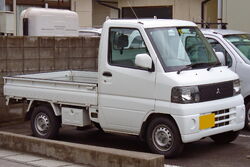 | |
| Manufacturer | Mitsubishi Motors |
|---|---|
| Also called |
Mitsubishi Varica (Taiwan) Mitsubishi L100 Nissan Clipper |
| Production | 1966–present |
| Assembly | Japan: Mizushima plant, Kurashiki, Okayama |
| Predecessor | Mitsubishi 360 |
| Class | Kei truck |
| Body style(s) | Pickup truck, microvan |
| Layout | FR layout, F4 layout |
| Engine(s) |
359cc ME24 I2 two-stroke 359cc 2G10 I2 two-stroke 471cc 2G22 I2 546cc G23B I2 644cc 2G24 I2 783cc 2G25 I2 548cc 3G81 I3 796cc 3G82 I3 659cc 4A30 I4 1.1L 4G82 I4 |
The Mitsubishi Minicab is a kei truck and microvan built and sold in Japan by Mitsubishi Motors since 1966.
First generation[]
The Minicab cab-over pickup truck was launched in 1966 to replace the 360, which by this time had adopted the same model name as the Minica sedan. It shared the sedan's air cooled two-stroke 359 cc engine, and came with cargo gates on three sides to simplify loading and unloading. In 1986 the van variant was introduced for the first time.[1]
Second generation[]
In 1971 the Minicab underwent its first model change, with the Minicab EL offering a new interior and a longer cargo bed. Ride quality was improved with the adoption of a front wishbone and rear leaf spring suspension. A panel van was added to the Minicab lineup in 1972, when it also became the Minicab W with the new watercooled 2G10 engine (hence the W).[1]
Third generation[]
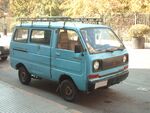
Third generation Minicab L100 van in Chile.
In 1977, the third generation Minicab was introduced. In keeping with the changes in vehicle tax regulations, the Minicab Wide 55 featured an increase in both width and length, and adopted the enlarged 471 cc engine from the car line. It also incorporated new features like a windscreen defroster, a central console box and a central ventilation system. It continued until 1981, when Mitsubishi dropped "Wide 55" from the Minicab name as the market was now aware of the increase in body size and engine capacity. A rear window wiper, electronic locking rear gate and power brakes were adopted, and in 1983 the Flat-floor Van model adopted a double-walled construction to offer a flat, open cargo area. For some export markets, like Chile, this version was known as Mitsubishi L100.[1] In China the third generation was build and sold as both the Shenwei SYW 1010 and the Wuling LZ 110.[2]
Fourth generation[]
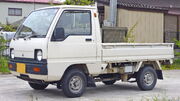
Fourth generation Minicab truck.
Further model range updates have been in parallel with the Minica, starting with the fourth generation's introduction in 1984. Although improvements were made to enhance the Minicab's commercial applications, the most noticeable changes were made to support personal leisure activities. Angular headlamps played an important role in the Minicab's styling, along with larger windows to improve visibility. Mitsubishi offered fifteen front- and four-wheel drive van model variations and ten truck variations. The fourth generation Minicab incorporated many class-leading features such as an automatic free-wheel hub adopted on all four-wheel drive models, while two-wheel drive models had a turning radius of 3.7 metres (12.1 ft). The estate models featured the first sliding sunroof in their class. In 1987, the Minicab became the first manufacturer to offer a supercharged kei car.[1] In China the fourth generation Minicab was built and sold as the Wuling LZW 1010 for the commercial variants and the Wuling LZW 6330 for the passenger variant.[2]
Fifth generation[]

Fifth generation Minican van.
A larger and completely redesigned Minicab was released in 1991 to take advantage of tax regulations allowing for increased dimensions and engine capacity of kei cars. Three new 660cc engines were introduced: a 4-valve SOHC unit, a 5-valve DOHC unit and a 2-valve SOHC unit. Across the range, there was a total of 66 possible model variations.[1] This included a new variant, the retro-styled Bravo Route 66, however, one previous variant, the high-roof truck, was discontinued.[2]
Sixth generation[]
The sixth generation Minicab was introduced in 1999 now sporting a new semi-front design. By April 1999, a "wagon" version called the Town Box was introduced.
Minicab MiEV[]
In January 2011, it is reported that Mitsubishi will add an electric version of Minicab, Minicab MiEV, for sales in Japan in Autumn 2011. The commercial use electric vehicle is estimated to have a range of 100 km (62 miles) with a full charge, which is lower than that of i-MiEV, in a bid to reduce costs. The price is aimed for less than ¥2,000,000 (about US$24,450) after subsidies.[3]
Nissan Clipper[]
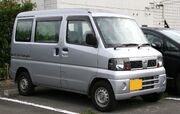
Nissan Clipper van.
Mitsubishi also manufacturers a badge-engineered version of the Minicab pickup on behalf of Nissan, which sells it as the Nissan Clipper. The Minicab competes in Japan with the Honda Acty, Subaru Sambar, Daihatsu Hijet, and the Suzuki Carry.
Varica[]
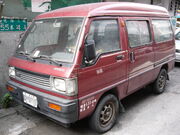
1980's CMC Varica
In Taiwan, as in mainland China, long wheelbase iterations of the fourth generation Minicab were also available with a variety of bodywork. The Taiwanese version (built by CMC, China Motor Corporation) was called the Varica and was available with a 1,061 cc 4G82 engine with 58 PS (43 kW). Overall length was up to 3,645 mm (143.5 in), with a wheelbase lengthened to 1,475 mm (58.1 in) right in front of the rear axle. Top speed was 115 km/h (71 mph).[4] The Varica's nose was also extended somewhat.
Later a 1.2-litre version replaced the smaller 1100.
References[]
| This page uses some content from Wikipedia. The original article was at Mitsubishi Minicab. The list of authors can be seen in the page history. As with Tractor & Construction Plant Wiki, the text of Wikipedia is available under the Creative Commons by Attribution License and/or GNU Free Documentation License. Please check page history for when the original article was copied to Wikia |
- ↑ 1.0 1.1 1.2 1.3 1.4 "Minicab". Mitsubishi Motors History. Mitsubishi-Motors.co.za. Retrieved on 20 April 2011.
- ↑ 2.0 2.1 2.2 Schaefers, Martin. "History of Japanese Kei Class Minivans and Trucks". Far East Auto Literature. Retrieved on 20 April 2011.
- ↑ Isabel Reynolds (2011-0-11). "Mitsubishi Motors to use Toshiba battery in EV: report", Reuters.
- ↑ (1991) Mitsubishi Varica New Tone 1100 (catalog). Old Car Manual Project. Retrieved on 2010-10-12.
External links[]
- Mitsubishi Minicab official site (Japanese)
- Mitsubishi Minicab history, Mitsubishi Motors South Africa website
- History of Mitsubishi Kei Jidosha
| |||||||||||||||||
| Mitsubishi car and light van timeline, 1960-1979 | |||||||||||||||||||||||||||||||||||||||||||||||||
|---|---|---|---|---|---|---|---|---|---|---|---|---|---|---|---|---|---|---|---|---|---|---|---|---|---|---|---|---|---|---|---|---|---|---|---|---|---|---|---|---|---|---|---|---|---|---|---|---|---|
| Type | 1960s | 1970s | |||||||||||||||||||||||||||||||||||||||||||||||
| 0 | 1 | 2 | 3 | 4 | 5 | 6 | 7 | 8 | 9 | 0 | 1 | 2 | 3 | 4 | 5 | 6 | 7 | 8 | 9 | ||||||||||||||||||||||||||||||
| Kei sedan | Minica | Minica 70-73 | Minica F4 | Minica 5 | Minica Ami 55 | ||||||||||||||||||||||||||||||||||||||||||||
| Minica Skipper | |||||||||||||||||||||||||||||||||||||||||||||||||
| Kei truck/ commercial | 360 Van/Pickup | Minica Van | Minica 5 Van |
Minica 55 Van | |||||||||||||||||||||||||||||||||||||||||||||
| Minicab | Minicab EL | Minicab W | Minicab 5 | Minicab Wide 55 | |||||||||||||||||||||||||||||||||||||||||||||
| Subcompact | 500 | Colt 600 | Colt 800 | ||||||||||||||||||||||||||||||||||||||||||||||
| Colt 1000F | Colt 1100F/11-F | ||||||||||||||||||||||||||||||||||||||||||||||||
| Compact | Colt 1000 | Colt 1100 | Colt 1200 | Lancer | Lancer EX | ||||||||||||||||||||||||||||||||||||||||||||
| Colt 1500 | (Colt) Galant | Galant | Galant Σ | ||||||||||||||||||||||||||||||||||||||||||||||
| Sport coupé | Galant FTO | Lancer Celeste | |||||||||||||||||||||||||||||||||||||||||||||||
| Galant GTO | Galant Λ | ||||||||||||||||||||||||||||||||||||||||||||||||
| Executive | Debonair | ||||||||||||||||||||||||||||||||||||||||||||||||